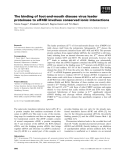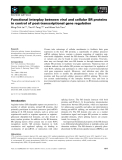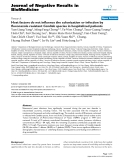
Host factors
-
Seed-borne rice endophytes are capable of disseminating into host plant tissues as well as to their rhizosphere. Here, we investigated the occurrence of siderophore-producing bacteria (SPB) in the seed endospheres of two distinct rice (Oryza sativa L.) cultivars, TK8 (ssp. japonica) and TCN1 (ssp. indica), and their dissemination into the rhizospheres through culture-dependent methods.
 13p
13p  vibecca
vibecca
 01-10-2024
01-10-2024
 2
2
 1
1
 Download
Download
-
The present study contributed to the body of knowledge by providing a theoretical framework in modelling and predicting host residents’ interactive behaviour towards tourists, and a comprehensive understanding of the roles that psychologic, demographic and socio-graphic factors plays in the different directions of community attitudes towards tourism. It also provided tourism authorities with practical recommendations and implications in terms of tourism planning and a harmonious relationship between the host residents and tourists.
 178p
178p  runthenight04
runthenight04
 02-02-2023
02-02-2023
 11
11
 5
5
 Download
Download
-
Less than 3 decades ago, Robin Warren and Barry Marshall definitively identified Helicobacter pylori by culturing an organism from gastric biopsy specimens that had been visualized for almost a century by pathologists (196). In 1994, H. pylori was recognized as a type I carcinogen, and now it is considered the most common etiologic agent of infection-related cancers, which represent 5.5% of the global cancer burden (239). In 2005, Marshall and Warren were awarded the Nobel Prize of Medicine for their seminal discovery of this bacterium and its role in peptic ulcer disease
 27p
27p  nguyendangbao1965
nguyendangbao1965
 04-06-2015
04-06-2015
 43
43
 4
4
 Download
Download
-
To establish an infection, Yersinia pseudotuberculosis utilizes a plasmid-encoded type III secretion machine that permits the translocation of several anti-host factors into the cytosol of target eukaryotic cells. Secreted YopD is essential for this process. Pre-secretory stabilization of YopD is mediated by an interaction with its cognate chaperone, LcrH. YopD possesses LcrH binding domains located in the N-terminus and in a predicted amphipathic domain located near the C-terminus. This latter domain is also critical for Yersinia virulence. ...
 10p
10p  research12
research12
 01-06-2013
01-06-2013
 48
48
 3
3
 Download
Download
-
Virus infection results in the activation of a set of cellular genes involved in host antiviral defense. IRF-3 has been identifiedas a critical transcription factor in this process. The activationmechanismof IRF-3 is not fully elucidated,yet it involves a conformational change triggered by the virus-dependent phosphorylation of its C-terminus. This con-formational change leads to nuclear accumulation,DNA binding and transcriptional transactivation.
 10p
10p  tumor12
tumor12
 22-04-2013
22-04-2013
 38
38
 3
3
 Download
Download
-
Several microbial pathogens have been reported to interact with glycosaminoglycans (GAGs) on cell surfaces and in the extracellularmatrix. Herewe demonstrate thatM protein, a major surface-expressed virulence factor of the human bac-terial pathogen, Streptococcus pyogenes, mediates binding to various forms of GAGs. Hence, S. pyogenesstrains expressing a large number of different types of M proteins bound to dermatan sulfate (DS), highly sulfated fractions of heparan sulfate (HS) and heparin, whereas strains deficient in M protein surface expression failed to interact with these GAGs. ...
 9p
9p  fptmusic
fptmusic
 16-04-2013
16-04-2013
 44
44
 6
6
 Download
Download
-
The leader proteinase (L pro ) of foot-and-mouth disease virus (FMDV) ini-tially cleaves itself from the polyprotein. Subsequently, L pro cleaves the host proteins eukaryotic initiation factor (eIF) 4GI and 4GII. This prevents protein synthesis from capped cellular mRNAs; the viral RNA is still trans-lated, initiating from an internal ribosome entry site. L pro cleaves eIF4GI between residues G674 and R675. We showed previously, however, that L pro binds to residues 640–669 of eIF4GI.
 10p
10p  awards
awards
 06-04-2013
06-04-2013
 36
36
 4
4
 Download
Download
-
The bacterial Lsm protein, host factor I (Hfq), is an RNA chaperone involved in many types of RNA transactions such as replication and stabil-ity, control of small RNA activity and polyadenylation. In this latter case, Hfq stimulates poly(A) synthesis and binds poly(A) tails that it protects from exonucleolytic degradation. We show here, that there is a correlation between Hfq binding to the 3¢ end of an RNA molecule and its ability to stimulate RNA elongation catalyzed by poly(A)polymerase I.
 0p
0p  awards
awards
 05-04-2013
05-04-2013
 27
27
 1
1
 Download
Download
-
TheHfq (Host factor 1) polypeptide is anucleic acidbinding protein involved in the synthesis of many polypeptides. Hfq particularly affects the translation and the stability of several RNAs. In an earlier study, the use of fold recog-nition methods allowed us to detect a relationship between Escherichia coliHfq and the Sm topology. This topology was further validated by a series of biophysical studies and theHfqstructurewasmodelledonanSmprotein.Hfq forms ab-sheet ring-shaped hexamer.
 8p
8p  dell39
dell39
 03-04-2013
03-04-2013
 53
53
 4
4
 Download
Download
-
Metallothioneins (MTs) constitute a family of cysteine-rich metalloproteins involved in cytoprotection during pathology. In mammals there are four isoforms (MT-I )IV), of which MT-I and -II (MT-I + II) are the best characterized MT proteins in the brain. Accumulating studies have demon-strated MT-I + II as multipurpose factors important for host defense responses, immunoregulation, cell survival and brain repair.
 14p
14p  inspiron33
inspiron33
 26-03-2013
26-03-2013
 30
30
 4
4
 Download
Download
-
Malaria is caused by protozoan parasites of the genusPlasmodiumand is a major cause of mortality and morbidity worldwide. These parasites have a complex life cycle in their mosquito vector and vertebrate hosts. The pri-mary factors contributing to the resurgence of malaria are the appearance of drug-resistant strains of the parasite, the spread of insecticide-resistant strains of the mosquito and the lack of licensed malaria vaccines of proven efficacy.
 10p
10p  media19
media19
 04-03-2013
04-03-2013
 35
35
 2
2
 Download
Download
-
Viruses take advantage of cellular machineries to facilitate their gene expression in the host. SR proteins, a superfamily of cellular precursor mRNA splicing factors, contain a domain consisting of repetitive argi-nine⁄serine dipeptides, termed the RS domain.
 10p
10p  vinaphone15
vinaphone15
 27-02-2013
27-02-2013
 35
35
 3
3
 Download
Download
-
HIV-1 is a retrovirus that causes AIDS in humans. The RNA genome of the virus encodes a Gag polyprotein, which is further processed into matrix, capsid and nucleocapsid proteins. These proteins play a significant role at several steps in the viral life cycle.
 10p
10p  viettel02
viettel02
 20-02-2013
20-02-2013
 34
34
 3
3
 Download
Download
-
In uropathogenic Escherichia coli, UPEC, different types of fimbriae are expressed to mediate interactions with host tissue. FocB belongs to the PapB family of transcription factors involved in the regulation of fimbriae gene clusters. Recent findings suggest that members from this family of proteins may form homomeric or heteromeric complexes and exert both positive and negative effects on the transcription of fimbriae genes.
 14p
14p  viettel02
viettel02
 19-02-2013
19-02-2013
 48
48
 4
4
 Download
Download
-
Tumour necrosis factor-a(TNF-a) is a key mediator of inflammation in host defence against infection and in autoimmune disease. Its production is controlled post-transcriptionally by multiple RNA-binding proteins that interact with the TNF-aAU-rich element and regulate its expression; one of these is Fragile X mental retardation-related protein 1 (FXR1).
 12p
12p  mobifone23
mobifone23
 21-01-2013
21-01-2013
 40
40
 3
3
 Download
Download
-
One of the important determinants of virulence of Mycobacterium tuberculosis is adaptation to adverse conditions encountered in the host cells. The ability of Mycobacteriumto successfully adapt to stress condi-tions is brought about by the expression of specific regulons effected by a repertoire of rfactors.
 22p
22p  mobifone23
mobifone23
 18-01-2013
18-01-2013
 66
66
 5
5
 Download
Download
-
Anthrax lethal toxin triggers death in some cell types, such as macrophages, and causes a variety of cellular dysfunctions in others. Collectively, these effects dampen the innate and adaptive immune systems to allowBacillus anthracis to survive and proliferate in the mammalian host.
 9p
9p  mobifone23
mobifone23
 18-01-2013
18-01-2013
 33
33
 3
3
 Download
Download
-
Tuyển tập báo cáo các nghiên cứu khoa học quốc tế ngành y học dành cho các bạn tham khảo đề tài: Host predisposition by endogenous Transforming Growth Factor-β1 overexpression promotes pulmonary fibrosis following bleomycin injury...
 14p
14p  thulanh27
thulanh27
 13-12-2011
13-12-2011
 31
31
 3
3
 Download
Download
-
Tuyển tập báo cáo các nghiên cứu khoa học quốc tế ngành y học dành cho các bạn tham khảo đề tài: Host factors do not influence the colonization or infection by fluconazole resistant Candida species in hospitalized patients
 5p
5p  panasonic01
panasonic01
 12-12-2011
12-12-2011
 56
56
 5
5
 Download
Download
-
Tuyển tập các báo cáo nghiên cứu về y học được đăng trên tạp chí y học Minireview cung cấp cho các bạn kiến thức về ngành y đề tài: A recessive genetic screen for host factors required for retroviral infection in a library of insertionally mutated Blm-deficient embryonic stem cells...
 0p
0p  thulanh20
thulanh20
 12-11-2011
12-11-2011
 56
56
 2
2
 Download
Download
CHỦ ĐỀ BẠN MUỐN TÌM
































